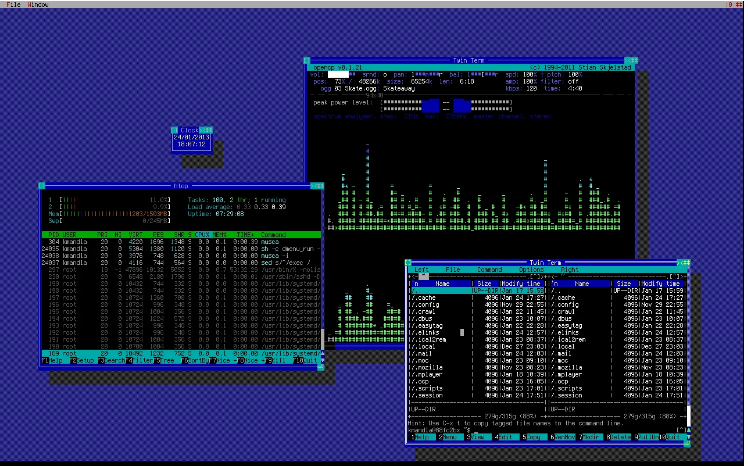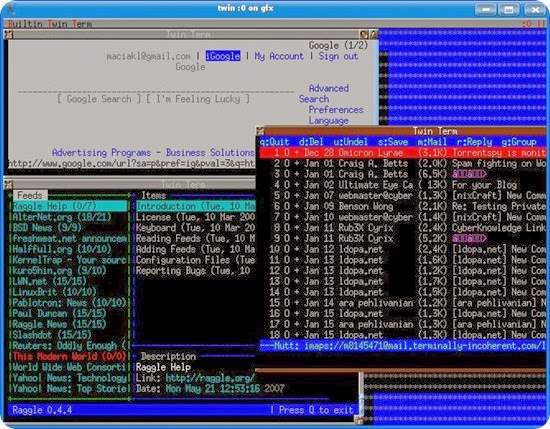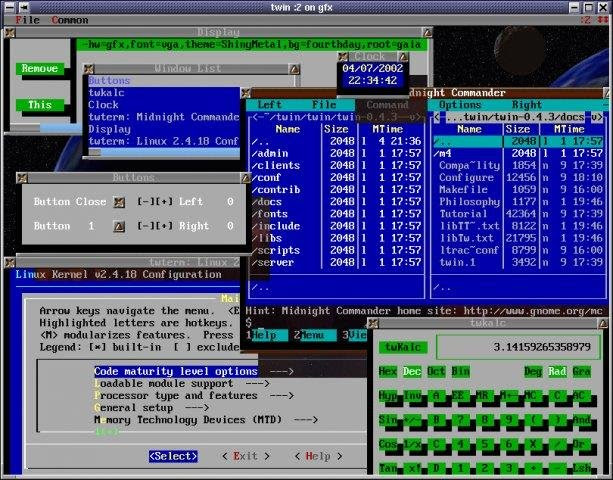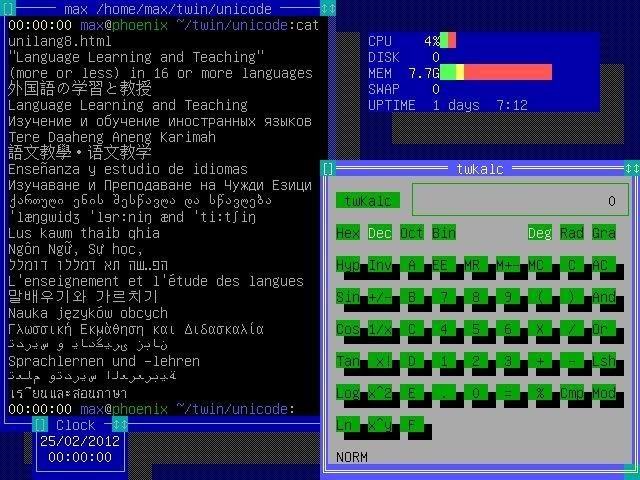
En un entorno Unix, un gestor de ventanas, es un conjunto de aplicaciones que te permiten manejar un ordenador visualmente, mediante el puntero del ratón, ventanas, botones y combinaciones de teclas. En los entornos de escritorio, éstos traen integrados un gestor de ventanas.
Para KDE está KWin, para GNOME, Metacity, para Xfce está Xfwm, y en LXDE es usado Openbox. Otros gestores de ventanas son Fluxbox, IdeWM y Compiz, este último es muy popular por los efectos gráficos que posee. Estos son totalmente intercambiables, puede usarse por ejemplo GNOME con Compiz, o KDE con Openbox.
Esta es una de las ventajas de GNU/Linux: la variedad y la personalización. En Linux, no es imprescindible un gestor de ventanas, pero hoy en día todas las distribuciones suelen traer uno o varios por defecto. La ausencia de (o incapacidad de ejecución) de un gestor de ventanas deja por defecto un intérprete de comandos, también llamado consola o Shell Unix.

Es una forma de usar un ordenador que necesita muy pocos recursos. Hoy en día su uso exclusivo lo tienen servidores web.
Se puede acceder al intérprete de comandos con Ctrl+Alt+(F1 a F6), siendo Ctrl+Alt+F7 el entorno de escritorio. Un gestor de ventanas no es otra cosa que el conjunto de programas, ventanas, funcionalidades, .... que hacen posible que el usuario pueda interactuar con el sistema de forma gráfica y no en modo texto.

Revolviendo un poco internet me topé con Twin un entorno de ventanas basado en terminales.
Todavía no lo probé mucho como para comentar al respecto, pero lo que sí hice (y que no es trivial), fue compilarlo.
Existe un pequeño bug en el makeautoconf.
Instalación.
- Descarguen el tar.gz desde el sourceforge oficial
- Descomprimanlo donde quieran y desde una terminal, y parados sobre ese directorio, ejecuten ./configure
- Editen el archivo makeautoconf ubicado en la raiz de la carpeta descomprimida en el paso 2 y editen la línea ECHO_E:=echo -e para que se vea de la siguiente manera ECHO_E:=/bin/echo -e
- Luego ejecuten make y como root make install
- Para que no se queje sobre algunas librerías dinámicas ejecuten como root el comando ldconfig
- Ejecuten Twin con el comando twstart.

In a Unix environment, a window manager is a set of applications that allow you to manage a computer visually, using the mouse pointer, windows, buttons and key combinations. In desktop environments, these come with an integrated window manager.
For KDE there is KWin, for GNOME there is Metacity, for Xfce there is Xfwm, and in LXDE Openbox is used. Other window managers are Fluxbox, IdeWM and Compiz, the latter is very popular for the graphic effects it has. These are completely interchangeable, you can use, for example, GNOME with Compiz, or KDE with Openbox.
This is one of the advantages of GNU/Linux: variety and customization. In Linux, a window manager is not essential, but nowadays all distributions usually come with one or more by default. The absence of (or inability to execute) a window manager leaves a command interpreter, also called a console or Unix Shell, by default.

It is a way of using a computer that requires very few resources. Today its exclusive use is for web servers.
The shell can be accessed with Ctrl+Alt+(F1 to F6), with Ctrl+Alt+F7 being the desktop environment. A window manager is nothing more than the set of programs, windows, functionalities,... that make it possible for the user to interact with the system graphically and not in text mode.
Searching the internet a little I came across Twin, a terminal-based window environment.
I haven't tested it enough yet to comment on it, but what I did do (and which is not trivial) was compile it.
There is a small bug in makeautoconf.
Installation.
- Download the tar.gz from the official sourceforge
- Unzip it wherever you want and from a terminal, and standing on that directory, run ./configure
- Edit the makeautoconf file located at the root of the unzipped folder in step 2 and edit the line ECHO_E:=echo -e so that it looks like this ECHO_E:=/bin/echo -e
- Then run make and as root make install
- To avoid complaining about some dynamic libraries, run the ldconfig command as root
- Run Twin with the twstart command.
Capturas de pantallas / Screenshots:
| Blogs, Sitios Web y Redes Sociales / Blogs, Webs & Social Networks | Plataformas de Contenidos/ Contents Platforms |
|---|---|
| Mi Blog / My Blog | Los Apuntes de Tux |
| Mi Blog / My Blog | El Mundo de Ubuntu |
| Mi Blog / My Blog | Nel Regno di Linux |
| Mi Blog / My Blog | Linuxlandit & The Conqueror Worm |
| Mi Blog / My Blog | Pianeta Ubuntu |
| Mi Blog / My Blog | Re Ubuntu |
| Mi Blog / My Blog | Nel Regno di Ubuntu |
| Red Social Twitter / Twitter Social Network | @hugorep |

| Blurt Official | Blurt.one | BeBlurt | Blurt Buzz |
|---|---|---|---|
 |  |  |  |
 |  |  |  |
|---|

Upvoted. Thank You for sending some of your rewards to @null. Read my last posts to make sure that BLURT burning is profitable for you. Before using this bot please make sure your account has at least 100 BP. Get more BLURT:
@ mariuszkarowski/how-to-get-automatic-upvote-from-my-accounts@ blurtbooster/blurt-booster-introduction-rules-and-guidelines-1699999662965@ nalexadre/blurt-nexus-creating-an-affiliate-account-1700008765859@ kryptodenno - win BLURT POWER delegation@ ctime/burn-bot-liquid-blurtThanks!!